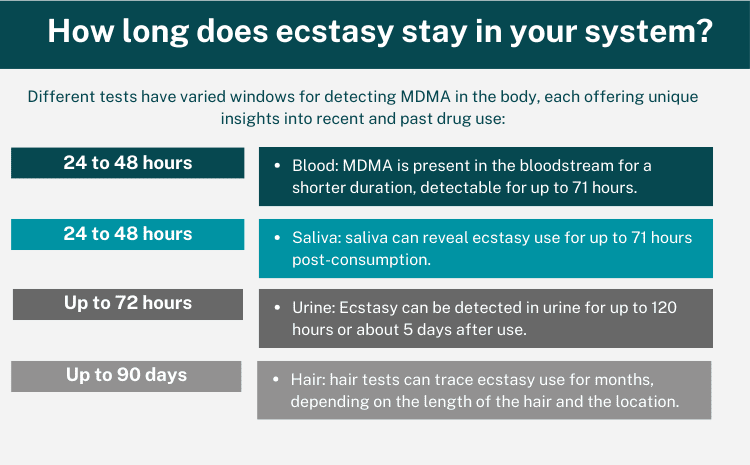23 Jan How long does ecstasy stay in your system?
Ecstasy, also known as MDMA, has been a subject of much discussion and concern. Initially popular in nightclubs and dance parties, its influence has now spread far beyond the dance floor. This substance, which is used by an estimated 2.2 million people, raises important questions about its effects on our bodies and minds.
It is particularly common among young adults, especially males between the ages of 18 and 25, with many starting to use it around the age of 21. Interestingly, research from the National Institute on Drug Abuse (NIDA) shows that MDMA use is more prevalent among gay or bisexual individuals.
With such a high level of consumption, it’s crucial to understand the potential risks associated with MDMA use. While many may perceive it as a harmless party drug, the reality is that ecstasy can cause several harmful effects, some of which can be fatal.
Moreover, the duration MDMA remains in the body varies and is influenced by several factors. Ecstasy is detectable for up to 3 days in blood and saliva tests, and its presence can be found in urine tests for up to 5 days.

Understanding Ecstasy: What Is MDMA?
MDMA, or methylenedioxymethamphetamine, is a synthetic drug known for its stimulant properties. It creates an energizing feeling, alters time and perception, and enhances sensory experiences. Often called ecstasy in its pill or capsule form, it’s a popular choice for those seeking heightened sensory and emotional experiences. However, it’s important to note that ecstasy tablets can vary in MDMA concentration. They may also contain other substances which can be harmful.
Effects of Ecstasy on Body and Mind
Ecstasy, known for its highs, has deep effects on both the body and mind. Understanding these impacts is vital in addressing ecstasy abuse. In the following section, we will explore the effects of MDMA on our physical and psychological states and why these changes matter.
Physical Effect of MDMA
Ecstasy’s impact on the body varies with dosage and individual response. Here are some common physical effects:
- Increased Heart Rate and Blood Pressure
- Elevated Body Temperature
- Muscle Tension
- Nausea
- Feeling Faint
- Chills or Sweating
- Boosted Energy Levels
- Lowered Inhibitions
- Altered Sensory Perception
- Increased Empathy
- Desire for Physical Closeness
- Elevated Mood
- Increased Sexual Arousal
These effects, while sought after by some, can lead to adverse reactions and risks, especially when combined with other substances or in uncontrolled environments.
Psychological Impacts of Ecstasy Use
Ecstasy’s impact on the brain is significant, affecting mood and cognition. Here are some key emotional and psychological effects:
- Aggression
- Anxiety.
- Irritability.
- Depression.
- Problems with memory
- Issues with paying attention
These effects, sometimes lasting over a week, highlight the potential risks of ecstasy addiction and its impact on mental health.
Health Risks of Long-Term Ecstasy Use
Long-term use of ecstasy, or MDMA, can lead to a range of serious health issues that go beyond the immediate effects of the drug. When used over an extended period, the risks escalate, affecting various aspects of physical and mental health. Some of the key concerns include:
- Cardiovascular Stress
- Dehydration Risks
- Emotional Disturbances
- Serotonin Depletion
- Brain Toxicity
- Memory Impairment.
- Brain Damage
In addition to these health risks, it’s important to recognize that ecstasy abuse can also lead to addiction. This addiction can be both psychological and physical. Understanding the full spectrum of risks associated with long MDMA use is crucial for both users and healthcare professionals.
How long does ecstasy stay in your system
The length of time ecstasy, or MDMA, stays in your system varies. Factors like metabolism rate and dosage affect how long MDMA can be detected. This is important for understanding the life of MDMA in the body and recognizing traces of ecstasy.
Key Factors Affecting MDMA's Presence
Dose and frequency of use
The amount and how often you use ecstasy greatly impact how long MDMA stays in your system. Larger doses take longer to metabolize, while frequent use means MDMA remains detectable for a more extended period compared to occasional use.
Method of consumption
The way ecstasy is consumed affects how long MDMA is detectable in the body. For instance, snorting the drug leads to quicker absorption into the bloodstream compared to swallowing it as a tablet. Therefore, snorted ecstasy will leave the body faster than if it’s taken orally.
Body type and metabolism
A person’s body type and metabolism rate play a role in how long ecstasy stays in their system. Drugs and their metabolites often get stored in fatty tissues. Therefore, individuals with a higher body mass index (BMI) or more body fat may take longer to completely eliminate ecstasy from their bodies.
General health status
Your overall health status also influences how MDMA is processed in your body. If you have health issues, especially with your liver or kidneys, MDMA may linger longer in your system. These organs are key in detoxifying the body, so any impairment can slow down the elimination of the drug.
When ecstasy is used alongside other substances, like cocaine, the body’s elimination process slows down. This is because it has to break down multiple substances simultaneously. Combining MDMA with other drugs not only extends the time it stays in your system but also can increase the risk of adverse effects.
Ecstasy’s Detection and Half-Life
The half-life of MDMA is around 8 hours, meaning it takes about this time to reduce its concentration in the bloodstream by 50%. After one half-life, half of the initial amount remains. It typically takes about 5 half-lives, roughly 40 hours, for 95% of ecstasy to be eliminated from the body.
This half-life is a key factor in the drug test for ecstasy detection. Depending on the different drug tests used, the detection of MDMA varies significantly. For instance, urine tests can detect MDMA for a longer period compared to blood tests due to the way the body metabolizes and excretes the drug.
MDMA Detection Methods
Different tests have varied windows for detecting MDMA in the body, each offering unique insights into recent and past drug use:
- Urine Tests: These are commonly used due to their longer detection period. Ecstasy can be detected in urine for up to 120 hours or about 5 days after use.
- Blood Tests: MDMA is present in the bloodstream for a shorter duration, detectable for up to 71 hours, roughly 3 days.
- Saliva Tests: Offering a similar detection window to blood tests, saliva can reveal ecstasy use for up to 71 hours post-consumption.
- Hair Tests: Providing the longest detection window, hair tests can trace ecstasy use for months, depending on the length of the hair and the sample’s location on the head.
Drug Addiction Risks of Ecstasy
While waiting for ecstasy to leave the system for drug tests, it’s crucial to acknowledge the risk of addiction. Regular ecstasy use can lead to dependency, which often co-occurs with the misuse of other substances like cocaine, alcohol, or marijuana. Addressing ecstasy addiction is not just about passing a drug test; it’s about improving overall health and social well-being.
Coping with MDMA Withdrawal
When tackling withdrawal from MDMA, it’s vital to understand and manage the various symptoms that can arise. These symptoms are part of the body’s readjustment process after prolonged ecstasy use and can include fatigue, depression, difficulty concentrating, loss of appetite, sleep disturbances, anxiety, and irritability. These challenges often signify the body’s attempt to regain balance after substance abuse.
Key symptoms of MDMA withdrawal include:
- Fatigue: Feeling constantly tired and lacking energy.
- Depression: Experiencing mood swings and persistent sadness.
- Difficulty Concentrating: Struggling to focus and maintain attention.
- Loss of Appetite: Noticing changes or reductions in eating habits.
- Sleep Issues: Experiencing disturbed sleep patterns or insomnia.
- Anxiety: Feeling increased worry or nervousness.
- Irritability: Being more easily annoyed or angered.
Addressing MDMA withdrawal effectively is a key step in overcoming addiction to ecstasy. Professional MDMA addiction treatment provides structured support to help individuals cope with these symptoms. It often involves a combination of therapy, counseling, and sometimes medication to ease the withdrawal process.
Treating MDMA Addiction
While MDMA’s addictive nature may be debated, its impact on brain neurotransmitters is similar to other addictive substances. Users might develop tolerance and dependence and continue use despite negative consequences. However, compared to other drugs, ecstasy addiction and withdrawal symptoms are often less severe.
Treatment for MDMA addiction typically focuses on psychological support rather than physical symptom management. The next section will look into various effective treatment options for ecstasy addiction, exploring how they address both the psychological aspects of dependency and the challenges faced during recovery.
Detoxification Programs for MDMA Users
For ecstasy users seeking recovery, medical detoxification (detox) provides a crucial first step. Although no FDA-approved medications specifically treat ecstasy addiction, detox programs offer a safe environment to manage withdrawal symptoms and acute intoxication.
Choosing Between Inpatient and Outpatient Care
When considering treatment for MDMA addiction, the choice between inpatient and outpatient care is crucial:
- Inpatient Care: This option is ideal for individuals with a history of polysubstance use or co-occurring mental health conditions. It offers a high level of care with 24/7 support, where you live onsite and receive various therapies.
- Outpatient Care: Suitable for those with a supportive home environment or who require less intensive treatment. This option allows you to live at home and attend treatment sessions up to several times a week.
Each option offers unique benefits, and the choice depends on personal circumstances, the severity of addiction, and specific recovery needs.
Conclusion: Tackling MDMA Abuse Effectively
Addressing MDMA abuse requires awareness, support, and access to resources. Organizations like SAMHSA and their national helpline offer vital assistance and emotional support. Effectively tackling drug abuse involves understanding the drug’s impact, exploring treatment options, and providing help to those in need. Remember, recovery is possible with the right support and resources.

No Comments